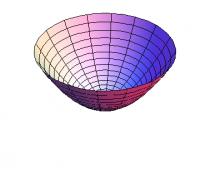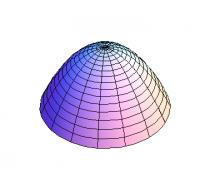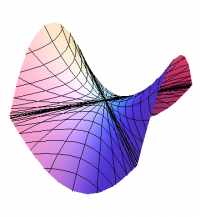Second Derivative Test
Why does the second derivative test work?
Recall that first derivatives tell you how to find the linear approximation to a function. For functions of two variables, we have \begin{equation} f(x+\Delta x,y+\Delta y) \approx f(x,y) + \Partial{f}{x}\Delta x + \Partial{f}{y}\Delta y \end{equation} which we can also write as \begin{equation} \Delta f \approx \Partial{f}{x}\Delta x + \Partial{f}{y}\Delta y \end{equation} At a local max/min, however, both partial derivatives vanish, and the linear approximation isn't good enough to see what is happening. Instead, we need the quadratic approximation, which turns out to be \begin{equation} \Delta f \approx \Partial{f}{x}\Delta x + \Partial{f}{y}\Delta y + \frac{\partial^2f}{\partial x^2}(\Delta x)^2 + 2\frac{\partial^2f}{\partial x\partial y}\Delta x\,\Delta y + \frac{\partial^2f}{\partial y^2}(\Delta y)^2 \end{equation} At a local extremum, the first two terms vanish, and we are left with \begin{equation} \Delta f \approx + \frac{\partial^2f}{\partial x^2}(\Delta x)^2 + 2\frac{\partial^2f}{\partial x\partial y}\Delta x\,\Delta y + \frac{\partial^2f}{\partial y^2}(\Delta y)^2 \label{approx2} \end{equation} So we need to understand the shape of a quadratic function of the form \begin{equation} h(x,y) = A x^2 + 2B xy + C y^2 \end{equation}
Consider first the simpler case when $B=0$. Then $h$ is parabolic along both the $x$ and $y$ axes; the only question is whether the parabolas open up or down. If $AC>0$, both parabolas open in the same direction, and the graph is a paraboloid, as shown in Figures 1 and 2, whereas if $AC<0$, the graph is saddle-shaped, as shown in Figure 3.
For the general case, we need some algebra. Assume $C\ne0$ and complete the square, yielding \begin{eqnarray} A x^2 &+& 2B\,x\,y + C y^2 \nonumber\\ &=& C \left(y+\frac{B}{C}x\right)^2 + \left( A - \frac{B^2}{C} \right) x^2 \nonumber\\ &=& C \left[\left( y+\frac{B}{C}x\right)^2 + \left( \frac{AC-B^2}{C^2} \right) x^2 \right] \end{eqnarray} and set $D=AC-B^2$. Then if $D>0$, the term in square brackets is positive, and the graph of h is a paraboloid, which opens up if $C>0$ (a min), and down if $C<0$ (a max), as shown in Figures 1 and 2, respectively. If $D<0$, then the term in square brackets is positive when $x=0$, but negative when $y=-\frac{B}{C}x$; this is a saddle, as shown in Figure 3. If $C=0$ but $A\ne0$, a similar argument can be made replacing $C$ by $A$. If $A=0=C$ but $B\ne0$, then $h=xy$, which is easily seen to be a saddle. But if all of $A$, $B$, and $C$ vanish, anything can happen; we need more information. Since $D=0$ in this latter case, anything can happen if $D=0$.
Combining this argument with the form of $\Delta f$ given in (\ref{approx2}), we have \begin{equation} A = \frac{\partial^2 f}{\partial x^2} \qquad B = \frac{\partial^2 f}{\partial x\partial y} \qquad C = \frac{\partial^2 f}{\partial y^2} \end{equation} and the argument given here reproduces the second derivative rule given in § Optimization.


